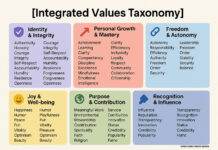What is Priority #1?
My old friend Warner visited me late last year. It had been a few years since we last met, and as our catch-up conversation meandered, he started pointing out many things. Things I thought were standard practice were not as I had thought.
Many parents take their kids to school, but few are on the launch team to form a school. Many people benefit from working for companies but being an adviser to a few companies helps many people with careers and income. Many aspire to write articles that can teach and transform lives, but few get them done.
Do not squander time because this is what life is made of.
I have a full-time professional IT career. I am also an accomplished semi-professional photographer, dancer, and author. I am also working on my family to influence two young kids positively. We are all given the same 24-hour days to utilize per day, but everyone uses it differently.
I tried to explain to him that my secret is my super supportive wife. As we spoke, the phone continually rang, and he pointed out something that was a blind spot to me. Warner said, “you multitask very well.”
MULTI-TASKING
I never thought this was my strength because I think multitasking is an optical illusion. Like any CPU, the human brain can only do one task at a time, and context switching forces our brain to swap tasks into and out of the brain. AKA lack of focus.
I have given this more thought, and after reading “Manage Your Time to Reduce Your Stress,” I have agreed with the author, Rita Emmett. Multitasking is all about doing more than one task, but it has to be “one thinking” and “one non-thinking” task. If you do two thinking tasks, that is not multitasking but multi-focused.
You can fold clothes and watch TV or exercise while you watch TV. You can drive your car and listen to audiobooks.
TIME WEALTHY MENTALITY
Since our conversation, I have been exploring the essence of my productivity. I want to share some of my secrets openly. One thing that stands out is that I sleep on average 6 hours, giving me more hours to get things done. I do not recommend this, but if you are up, make these hours count. You must be proactive, NOT passive, and do not wait for things to happen. Make them happen. There is no such thing as time management. There is only personal management. Personal Mastery makes you time wealthy.
PRIORITY
WHAT IS IMPORTANT IS KNOWING WHAT IS IMPORTANT — PETER DRUCKER
As I thought about it more and more, I realized that knowing the fundamentals of priority is a big part. First, you must live your dream, or someone will sign you up to live someone else’s. Once you know what you want, then you can quickly determine if the actions on your to-do list support your dream or not.
ABANDONMENT
You cannot do it all. You have a fixed amount of energy in a day to get it done. I spend as much time thinking about what I will not do as I make my to-do list. The irony is the more successful you become, the more people will bring you their ideas for you to help them make them a reality, making your list longer.
Luckily for me, Peter Drucker’s theory of “purposeful abandonment” is wedged somewhere in my subconscious.
“RESPONSIBLE ACTION THAT DELIVERS RESULTS, THE RIGHT ACTIONS, IMPORTANT ACTIONS. ABANDONMENT OF THINGS THAT DO NOT WORK IS THE FLIP SIDE TO INNOVATION; YOU CANNOT HAVE INNOVATION WITHOUT ABANDONMENT.” — INSIDE DRUKER’S BRAIN
I know this is obvious stuff, but the repetition of fundamentals increases the success of learning. All tasks fall into this matrix of urgent and important priorities. It would be best to take the right action based on the task to be productive.
There are templates available for printing and use in list management.
Note: Do not list any task that can be done in 2 minutes. Do it now.
| TASK | URGENT | IMPORTANT | ACTION TO TAKE |
|---|---|---|---|
| TASK1 | YES | YES | Do it now |
| TASK2 | YES | NO | If possible, do it quickly, then get it done. If it will take time, try to delegate it to someone, or you will have to delegate it to your calendar. |
| TASK3 | NO | YES | Set a deadline and block calendar time to finish them; do not allow interruptions. |
| TASK4 | NO | NO | Try to eliminate it, else then try to delegate it. If you must do it, schedule it for a time when you are least productive. |
Now, make three lists and reallocate the incoming requests.
- DO now
- Calendar
- Delegate or Multitask. If you have no one to delegate the task to. For example, you can complete this task while watching TV or doing something you enjoy.
| DO NOW List | ||
| # | TASK | STATUS |
|---|---|---|
| 1 | ||
| 2 | ||
| 3 | ||
| 4 | ||
| 5 | ||
| 6 | ||
| 7 | ||
| 8 | ||
| 9 | ||
| 10 | ||
| Calendar List | ||
| # | TASK | STATUS |
|---|---|---|
| 1 | ||
| 2 | ||
| 3 | ||
| 4 | ||
| 5 | ||
| 6 | ||
| 7 | ||
| 8 | ||
| 9 | ||
| 10 | ||
| Delegate List | ||
| # | TASK | STATUS |
|---|---|---|
| 1 | ||
| 2 | ||
| 3 | ||
| 4 | ||
| 5 | ||
| 6 | ||
| 7 | ||
| 8 | ||
| 9 | ||
| 10 | ||
I want to redefine the word “delegate” used in the matrix above. I do not pass my task on to a junior. I do not give the “scutt” work to the residents to rattle their brains for some busy time. I partner with experts. I try to find people who can solve this fast and put the problem to rest instead of letting it linger on for a few weeks with a less knowledgeable person.
We live in a far more complex world, where we manage personal, professional, and family responsibilities. If you block time for each of these types, you will eliminate competing top priorities from a list. It is hard to know which is more important for different list types. Another tip, as your list grows long and unruly, is to tame it using the Pareto principle, also known as the 80/20 rule. e.g., if you have ten important and urgent items, then select only two of the ten. i.e., 20% will give the majority or 80% of the results.
When prioritizing professional projects, especially in a portfolio or organizational context, it’s important to use a structured and transparent framework that balances strategic alignment, resource availability, risk, return, and urgency. Here’s a comprehensive list of factors to consider, along with a proposed weightage scheme.
Key Factors to Consider for Project Prioritization
| Factor | Description |
|---|---|
| 1. Strategic Alignment | How well does the project align with the organization’s goals and strategic initiatives? |
| 2. Business Value / ROI | What tangible and intangible value will the project deliver? Includes revenue, cost savings, or customer value. |
| 3. Urgency / Time Sensitivity | Are there deadlines, regulatory timelines, or market windows that require immediate action? |
| 4. Resource Availability | Are the required resources (people, budget, infrastructure) available? |
| 5. Cost | What is the estimated cost and budget requirement for the project? |
| 6. Risk / Complexity | What are the technical, operational, or market risks? How complex is the implementation? |
| 7. Impact / Reach | How broad or deep is the impact? (e.g., number of departments/customers/users affected) |
| 8. Dependencies | Does the project depend on or enable other projects? |
| 9. Compliance / Regulatory Need | Is the project required for compliance or legal reasons? |
| 10. Innovation / Competitive Advantage | Will the project provide a technological or market edge? |
| 11. Stakeholder Support | How strong is the support or demand from key stakeholders or customers? |
⚖️ Proposed Weightage (Total: 100 Points)
| Factor | Weight (%) | Reasoning |
|---|---|---|
| Strategic Alignment | 20% | Central to ensuring projects drive the core mission and vision. |
| Business Value / ROI | 20% | Directly contributes to measurable success and sustainability. |
| Urgency / Time Sensitivity | 10% | Important for seizing time-bound opportunities or avoiding delays. |
| Resource Availability | 10% | A project is only feasible if resources are realistically available. |
| Cost | 5% | Lower-weighted since cost should be considered in value analysis. |
| Risk / Complexity | 10% | Helps gauge the likelihood of success or overruns. |
| Impact / Reach | 10% | Amplifies value if the project benefits more people or systems. |
| Dependencies | 5% | Affects sequencing and overall roadmap feasibility. |
| Compliance / Regulatory Need | 5% | Critical in some industries but not always applicable to all projects. |
| Innovation / Competitive Advantage | 3% | Encouraged, but innovation alone may not be enough. |
| Stakeholder Support | 2% | Ensures internal buy-in but should not outweigh strategic or value factors. |
Prioritization Scorecard
You can rate each factor on a scale of 1–5 (or 1–10), then multiply the rating by the corresponding weight to obtain a final score. Projects can then be ranked by total score.
Sharing is Caring. Thanks for reading and Sharing ❤
Follow me On: Instagram | Facebook | Linked in
Subscribe for monthly Inspiration











